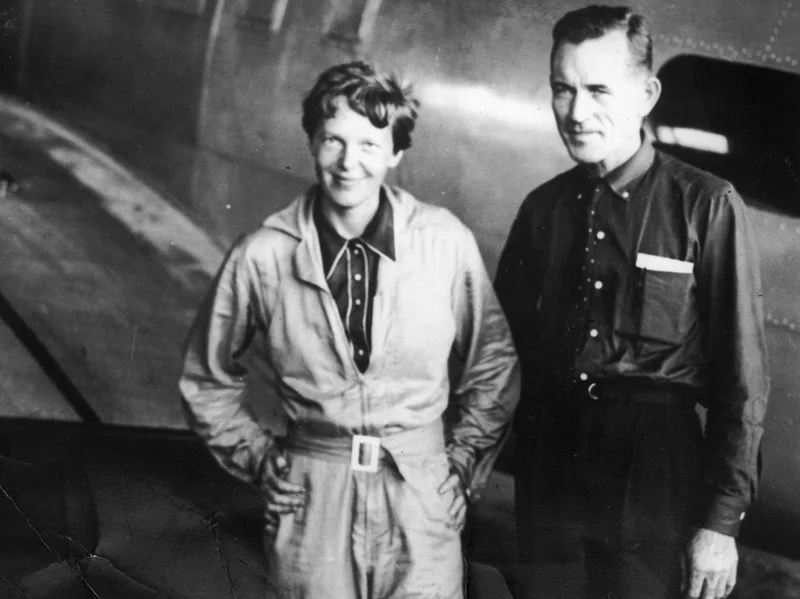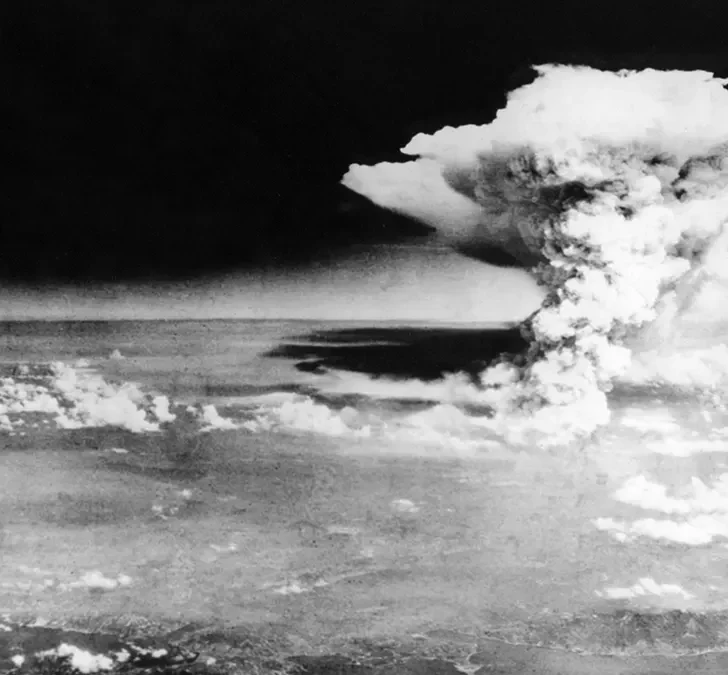It was warm the day Amelia Earhart and Fred Noonan took off from the Miami Municipal Airport, and the sun was shining.
Her Lockheed Electra had been giving her trouble for weeks, but after multiple repairs, she was about to bet her life, as well as the life of navigator Fred Noonan, on the reliability of the twin-engine monoplane.


She called it her “Flying Laboratory,” a name less catchy than the ones she had bestowed on her previous planes–the Lockheed Vega she called “Little Red Bus” and her first plane, a Kinner Airster she named “The Canary.”
But charismatic name or not, Earhart’s Lockheed and its two occupants were in for the trip of a lifetime.
A trip Earhart had failed before. A trip she would fail for a second time, never to be seen again. What happened when Amelia Earhart, Fred Noonan, and her Lockheed Electra disappeared?
Amelia Earhart Sets Out To Circumnavigate The Globe
No one would ever accuse Amelia of being slow. In fact, she was known to live her life at a fever pitch, and her second attempt to circumnavigate the globe was no different.
If she succeeded, she would be the first female pilot to accomplish the feat, adding to her already impressive resume.
Earhart was already the first woman ever to cross the Atlantic Ocean as a solo aviator, so a full globe crossing was one of the last things for her to conquer.
The problem was that she had already attempted crossing one before, just months earlier. A full global flight requires stops almost nearly every day–the Lockheed Electra had a maximum flight time of 24 hours at a time.
Unfortunately, Earhart’s first attempt would only make it a single stop before the plane experienced technical issues.
Amelia and her flight crew–three men plus Earhart–set off from Oakland, California for the first leg of the journey. Propeller issues plagued the Electra soon after, and Earhart landed at Pearl Harbor’s Luke Field, just west of Honolulu. There, she and her crew waited for repairs to be completed before resuming.
The Lockheed floundered again at takeoff, the landing gear collapsing and dumping the plane unceremoniously to the ground.
Defeated, and with most of her crew departing, the plan to circumnavigate the globe for Amelia Earhart had to be put on hold.
Amelia’s Second, And Final, Attempt
With the Electra undergoing extensive repairs, Amelia Earhart and her last remaining crew member, Fred Noonan, rushed to Miami. The plan was to rendezvous with the repaired Electra and immediately start their second attempt.
The fanfare that the first attempt had received was missing from the second take-off, but that may have been a calculated choice on Amelia’s end.
Still, she was confident–she had to be to attempt such a difficult flight with a diminished crew.
At the time, Amelia had reached celebrity status, and her success was hoped for by people all around the world. She had fans to please, even if she couldn’t see any of them when the Electra lifted from the tarmac.
Her first attempt had been on March 17, 1937. Her second came swiftly, and she and Noonan took flight for their next attempt on June 1, 1937. They would never set foot on American soil again.
Amelia Earhart’s Flight Timeline
While Amelia’s circumnavigation attempt is forever associated with her disappearance, first and foremost, Amelia and Fred had actually completed a majority of the journey before vanishing off the face of the earth.

Amelia Earhart and Fred Noonan would lose contact with ground support and subsequently disappear on July 2, 1937. By that point, they had successfully flown for 28 days and traveled nearly 22,000 miles out of a 29,000-mile trip.
Here is a timeline of Amelia Earhart’s final flight path, from takeoff on June 1 to disappearance on July 2.
- June 1, 1937-June 10, 1937- Earhart would fly eight parts of her trip during the first ten days. From Miami, Florida, she would travel to Puerto Rico, followed by Venezuela, Surinam, Brazil, Senegal, and Sudan.
- June 11, 1937-June 20, 1937- Over the next ten days Earhart would reach ten of her stops. After leaving Sudan she would fly to East Africa, followed by the now non-existent British India, Burma, Siam, and Singapore.
- June 21, 1937-July 2, 1937-The final eight days of Amelia’s trip would be fraught with issues. After leaving Singapore, she would travel to the Dutch East Indies, now known as Indonesia. A monsoon would cause the journey to be delayed, followed by Amelia suffering from a bout of dysentery. When they were finally able to take flight again, they would make a stop in Australia and, finally, New Guinea. They were due at Howland Island the next day, but as we know, the Electra and its two passengers would never arrive.
The Last Transmissions: Clues To The Disappearance
Despite people around the world cheering her on, Amelia Earhart had only Fred Noonan and the Electra around her during the longest and last leg of her flight. She wasn’t without support, though.
Not long before her disappearance, she was able to communicate with a ship stationed nearby–the Coast Guard’s Itasca–who waited to guide her to Howland Island.
She would tell them, “KHAQQ calling Itasca. We must be on you, but we cannot see you. Fuel is running low. Been unable to reach you by radio. We are flying at 1,000 feet.” Itasca attempted to reply, but the Electra couldn’t hear them. Then, she called out again at 7:30 am.
“KHAQQ calling Itasca. We are circling but cannot hear you. Go ahead on 7500 with a long count either now or on the schedule time on the half-hour.”
Then, at at 7:58 am,
“KHAQQ calling Itasca. We received your signals but unable to get a minimum. Please take bearing on us and answer 3105 with voice.”
Following this transmission, she sent a string of Morse code dashes to the Itasca, desperate to establish any form of two-way communication. Amelia Earhart’s last transmission to the Itasca, and subsequently, the world, came at 8:45 am.
“KHAQQ calling Itasca. We are on a line of position 157/337. We will repeat this message on 6210 kc. Running north and south.”
So, what do these last chilling communications tell us about the disappearance of Amelia Earhart?
Most importantly, the transcripts of these last messages make one thing exceedingly clear–the Electra’s equipment wasn’t capable of communicating with Itasca.
Earhart’s plane was set to a frequency that made it impossible to establish a connection with the ship.
The Electra was tuned into the 3105 kHz frequency, while the Itasca was on 7500 kHz. Earhart’s lack of radio knowledge, combined with potential damage to the Electra’s antennae, was a recipe for disaster.
What Happened To Amelia Earhart?
After her last transmission, nothing else was officially heard from Earhart and Noonan. Multiple attempts were made to contact the Electra.
An investigation was launched by the US government which determined that Amelia Earhart’s fuel calculations were off and that she crashed into the sea. Two years later she would be declared officially deceased.
The tragedy struck the public hard. People wanted to know what had happened to Amelia Earhart, but finding her wasn’t going to be easy. If she had stayed somewhat on course, her plane would have crashed near Howland Island, the tiny island in the Pacific that had been her destination.

The problem with that theory is that people were stationed both on Howland Island itself and the Itasca, and none of them saw any evidence of a crash nearby.
An hour after Earhart’s final transmission, the Itasca began a search for the doomed flight, the first part of an enormous search effort that would ultimately end on July 19, 1937.
The US military looked for Earhart by land and sea and would spend over $4 million to try and locate the downed plane and its occupants.
The search for Amelia would become the most costly search effort in history for the time. After the official search ended, Amelia’s husband would coordinate private searches for his wife, all of which would come to naught.
Theories Surrounding Earhart’s Disappearance
The US government claimed that Amelia Earhart’s plane crashed into the ocean, causing both occupants to drown and the wreckage of the Electra to be lost. But with no proof of this theory, speculation has run wild.
There are numerous alternative theories regarding Amelia and Fred’s fate, and some of them can even be considered credible.
While it’s easy to dismiss the more absurd ideas, like the theory that Amelia was one of numerous Tokyo Rose’s, one, the Gardner Island Hypothesis, may actually hold water.
Gardner Island (Nikumaroro) Hypothesis
The alternative theory that holds the most weight is undoubtedly the Gardner Island Hypothesis–and the evidence might have come from Amelia Earhart herself.
Gardner Island, now called Nikumaroro, is a tiny atoll south of Earhart’s intended target of Howland Island.
This theory proposes that, based on Earhart’s last location given to the Itasca, she would have been traveling in the direction of Gardner Island and potentially used it as an emergency landing location.
TIGHAR (The International Group for Historic Aircraft Recovery) collected evidence to prove this theory, including:
- A skeleton, a sextant box, a woman’s shoe, and an empty bottle of an herbal liqueur called Bénédictine were all found by Officer Gerland Gallagher during his search of the island in 1940. The initial determination was that the skeleton belonged to a man, but further analysis revealed that the bones were actually from a woman.
- In 1988, more potential Earhart artifacts were found–another woman’s shoe, potential improvised tools, and an aluminum panel thought to match a window covering pictured on the Electra right before its takeoff from Miami.
The strongest evidence for the Gardner Island hypothesis, though, might not even be tangible.
After Amelia Earhart disappeared, people all over the world were listening to their radios.
Some were looking for something to listen to, while others were hoping to hear a transmission from Earhart herself. A few listeners were amazed when they thought they might have actually heard from Amelia.
In the following two days, the Itasca and other robust military radio transmitters broadcasted requests for Amelia to respond on the 3105 kHz frequency.
Over the next two days, Morse code dashes, as well as the occasional word and phrase, were picked up on the frequency, but nothing definitive was found.
At around 4:00 am on July 4, multiple listeners pick up signals in different locations, some of them full sentences from what TIGHAR believes was Amelia.
- A 16-year-old in Wyoming hears Earhart saying her plane is stranded on a reef.
- A woman in Toronto hears who she claimed was Amelia and Fred conversing.
- Listening stations at Mokapu and Midway Island hear a voice over Amelia’s frequency and continue to pick up the signal for almost an hour.
Then, the most detailed potential Earhart transmission was picked up on July 5.
- Fifteen-year-old Betty Klenck from St. Petersburg, Florida, heard what she believed was Amelia Earhart while listening to her two-wave radio at her home. Betty listened carefully for nearly two hours, taking note of the distorted messages that she was receiving in her journal.
- Later, Betty and her father brought the journal to the local Coast Guard. This transmission was picked up just a few minutes after the Itasca, which was still searching for Amelia, made another attempt to contact her. Betty had no way of knowing that the Itasca was transmitting at the time.
It is still uncertain whether Amelia Earhart was alive on July 5 and waiting to be rescued from Gardner Island. The most probable scenario is that the Electra and its two passengers crashed into the sea and sank.
However, there is a possibility that Earhart and Noonan survived the crash, even if it was only for a few days. TIGHAR and other experts believe that some of the distress calls she transmitted through her damaged radio were received by Betty Klenck.
“This is Amelia Earhart,” Betty recorded in her journal. “Waters high…help us quick. George…get the suitcase in my closet. California.”
Betty’s notes could have been mere wishful thinking, but how did she come to know about the suitcase in the closet of Earhart’s California residence?
The suitcase was filled with Earhart’s records, and she had instructed both her mother and husband, George Putnam, to burn it if she ever disappeared.
It could have been a coincidence, or maybe Amelia Earhart survived a little longer, holding onto hope until the bitter end.
Sources
https://www.usni.org/magazines/naval-history-magazine/1993/december/amelia-didnt-know-radio
https://tighar.org/Projects/Earhart/Archives/Research/ResearchPapers/Worldflight/finalflight3.html
https://airandspace.si.edu/stories/editorial/legend-amelia-earharts-disappearance













Leave a comment